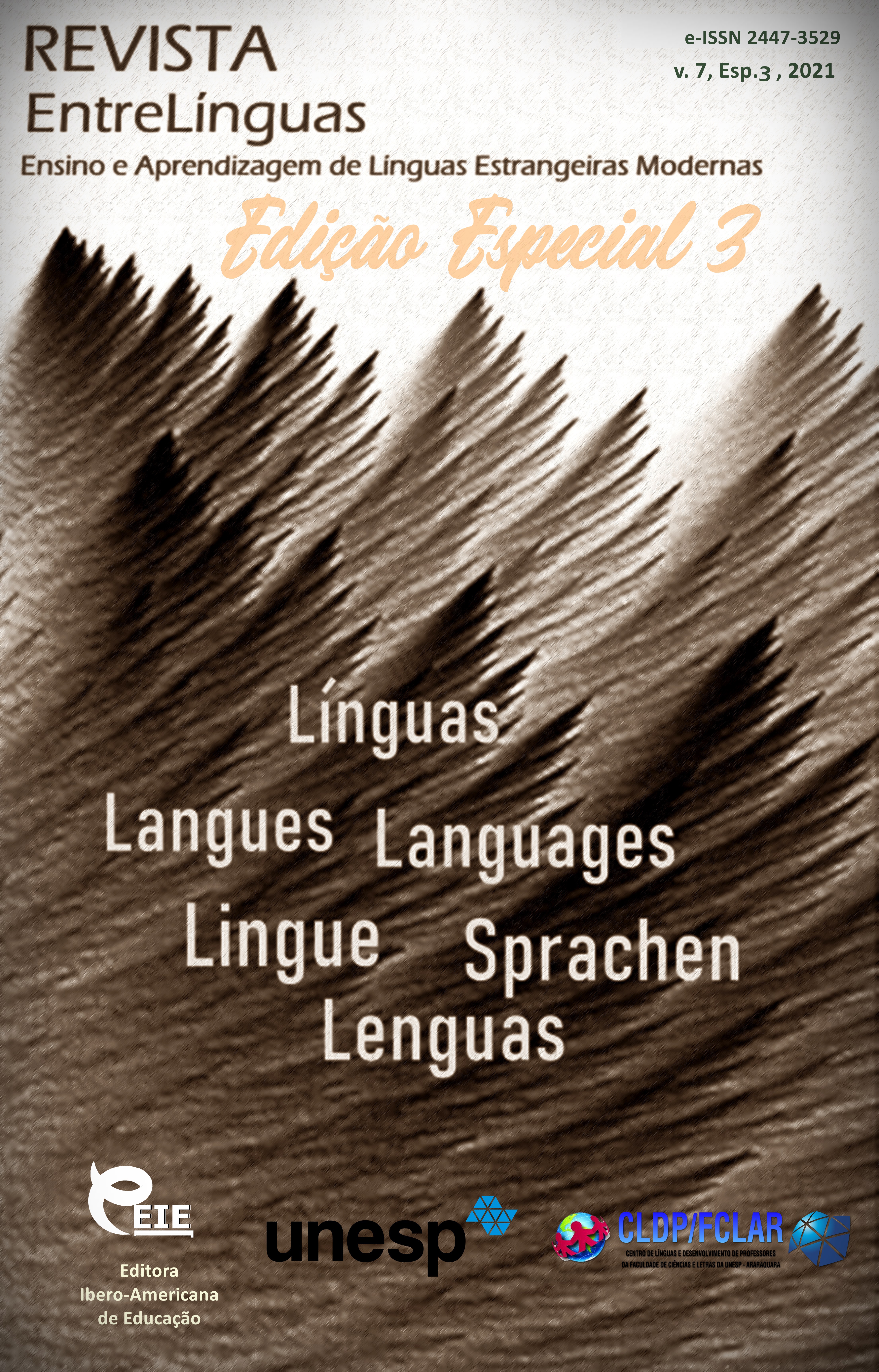Aspecto axiológico dos etnossímbolos modernos do alemão no ensino da língua alemã
DOI:
https://doi.org/10.29051/el.v7iesp.3.15734Palavras-chave:
Etnossimbolo, Classificação axiológica, Experimento associativo, Experimento linguoculturalResumo
A partir da abordagem axiológica, constatou-se que as orientações ético-morais da sociedade alemã foram internalizadas nas mentes das etnias e verbalizadas pelos etnossímbolos. Um etnossímbolo é um signo linguístico convencional motivado com múltiplos significados que incorpora conceitos culturais significativos. As razões para a formação dos etnossímbolos são a especificidade e a duração dos contatos interétnicos, as condições sociais, políticas e econômicas para o desenvolvimento dos grupos étnicos. A estrutura semântica do etnossímbolo é formada com base nas relações associativas nacionais comumente usadas em um determinado sistema de acordos sociolinguísticos. O objetivo do artigo é estabelecer os dominantes de valor da cultura alemã com base na análise dos símbolos étnicos como componentes importantes da imagem linguística do mundo. O significado simbólico como um repensar associativo dos significados diretos e figurativos da palavra envolve levar em consideração a função social e as especificidades etnoculturais do objeto denotado. As associações verbais nacionais são um pré-requisito para a formação da semântica simbólica da palavra, mas o envolvimento apenas de métodos linguísticos não fornece um estudo completo e abrangente. A conexão entre a linguagem e a consciência da linguagem pode ser explorada por meio de um experimento associativo. Os resultados de tal experimento tornam possível não apenas estabelecer as características da memória verbal, léxico mental, estereótipos culturais, mas também refletir as especificidades da visão de mundo da comunidade linguística. A maioria dos símbolos étnicos alemães objetiva conceitos como ordem, pontualidade, pureza, diligência, economia. O conjunto dos dominantes de valor cria um certo tipo de cultura que foi mantida na língua e é transferida de geração em geração.
Downloads
Referências
BEIER, B. Harenberg lexikon der sprichwörter & zitate: mit 50000 Einträgen das umfassendste Werk in deutscher Sprache. [Harenberg Lexicon of Proverbs and Quotes: with 50000 entries the most comprehensive work in German]. Dortmund. Harenberg, 2004.
CREUZER, F. Symbolik und mythologie der alten völker, besonders der griechen. [Symbolism and mythology of the ancient peoples, especially the Greeks]. Hildesheim: Olms, 1973.
DORNSEIFF, F. Der deutsche wortschatz nach sachgruppen [The German vocabulary according to subject groups]. Berlin: Gruyter, 1965.
DUDEN. Das große wörterbuch der deutschen sprache: in zehn bänden. Duden. Wien-Zürich: Dudenverlag, 1999.
FLEISCHER, M. Weltbildgesteuerte wirklichkeitskonstruktion (beiträge zum phänomen weltbild) [Weltbild Controlled Reality Construction (Contributions to the Phenomenon Weltbild)]. München: Otto Sagner Verlag, 1996.
HÜLST, D. Symbol und soziologische symboltheorie. [Symbol and sociological symbol theory.] Opladen: Leske Budrich, 1999.
KLUGE, F. Etymologisches wörterbuch der deutschen sprache [Etymological dictionary of the German language] bearb. von Elmar Seebold. Berlin; New York: de Gruyter, 2002.
KROLL, W. Geschichte der klassischen philologie [History of Classical Philology]. Berlin: de Gruyter, 1919.
LIPPMANN, W. Public opinion. New York, NY: The Free Press, 1922.
MÜRI, W. Symbolon: wort- und sachgeschichtliche Studie [Symbolon: Word and historical study]. Bern, 1931.
MUSTAYOKI A. O. O lingvisticheskih eksperimentah [About longuistik experiments]. Moscow: IRYa RAN, 1995.
PAUL, H. Deutsches wörterbuch: bedeutungsgeschichte und aufbau unseres wortschatzes [German dictionary: history of meaning and structure of our vocabulary]. Tübingen: Niemeyer, 2002.
POTEBNYA, A. A. O nekotorykh simvolakh v slavyanskoi narodnoi poezii [About some symbols in the Slavic folk poetry]. Potebni, 1914.
PRYKHODKO, M. Kontsepty i kontseptosystemy [Concepts and concept systems]. Zaporizhzhya: Premyer, 2013.
SCHLESINGER, M. Geschichte des symbols [History of the symbol]. Hildesheim: Olms Verlag, 1967.
VESELOVSKY, A. N. Mif i simvol [Myth and symbol]. Russkii fol’klor: Voprosy teorii fol'klora [Russian folklore: Questions of folklore theory]. 1979. n. 19, p. 186-199.
WAHRIG, G. Deutsches wörterbuch mit einem lexikon der deutschen sprachlehre [German dictionary with a lexicon of German language teaching]. München: Bertelsmann, 1986.
WALDERMANN, A. Werbeslogans: geiz war geil geizistgeil der spiegel. 2007. Available at: http://www.spiegel.de/wirtschaft/werbeslogans-geiz-war-geil-a-485489.html. Access: 10 Dec. 2020.
WEHRLE, H.; EGGERS, E. Deutscher wortschatz: ein wegweiser zum treffenden ausdruck [German vocabulary: a guide to apt expression]. Stuttgart: Klett, 1967.
WINTER, A. Dem deutschen volke [For German people] München: DSZ-Verlag, 2009.
Downloads
Publicado
Como Citar
Edição
Seção
Licença

Este trabalho está licenciado sob uma licença Creative Commons Attribution-NonCommercial-ShareAlike 4.0 International License.
Os manuscritos aceitos e publicados são de propriedade da Revista EntreLínguas. Os artigos publicados e as referências citadas na Revista EntreLínguas são de inteira responsabilidade de seus autores.
Transferência de direitos autorais – autorização para publicação
Caso o artigo submetido seja aprovado para publicação, já fica acordado que o(s) autor(es) autoriza(m) a UNESP a reproduzi-lo e publicá-lo na EntreLínguas, entendendo-se os termos “reprodução” e “publicação” conforme definição respectivamente dos incisos VI e I do artigo 5° da Lei 9610/98. O artigo poderá ser acessado pela rede mundial de computadores (Internet), sendo permitidas, a título gratuito, a consulta e a reprodução de exemplar do artigo para uso próprio de quem a consulta, desde que haja a citação ao texto consultado. Essa autorização de publicação 328 EntreLínguas, Araraquara, v. 1, n .2, p. 323-328, jul./dez. 2015 não tem limitação de tempo, ficando a UNESP responsável pela manutenção da identificação do(s) autor(es) do artigo. Os artigos publicados e as referências citadas na Revista EntreLínguas são de inteira responsabilidade de seus autores.











